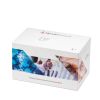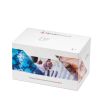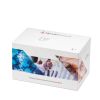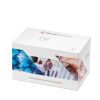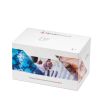Fecal Calprotectin, Human, Rapid ELISA kit - HK382
The fecal Calprotectin ELISA kit is to be used for the in vitro quantitative determination of human calprotectin in feces in 1-step with a working time of 1.5 hours.
Quantity
1 x 96 det.
Catalog #
HK382
756,00 €
Calprotectin, also known as S100A8/A9 heterocomplex, is formed out of the calcium-binding, migrating proteins S100A8 and S100A9. Calprotectin is a calcium- and zinc-binding protein complex composed of 8 and 14 kD subunits and complex formation is calcium dependent. Neutrophils are the main producers of calprotectin, but expression has also been found in monocytes, macrophages and ileal tissue eosinophils. Altogether, S100A8 and S100A9 proteins contribute to approximately 40–60% of the soluble, cytosolic content of granulocytes. Calprotectin has antibacterial, antifungal, immunomodulating and antiproliferative effects. Elevated concentrations of calprotectin can be measured among others in plasma, synovial fluid, urine and feces. The presence of calprotectin in feces quantitatively relates to neutrophil migration towards the gastrointestinal tract.
Calprotectin is therefore considered a reliable biomarker for intestinal inflammation throughout the gastrointestinal tract. Calprotectin in feces is stable for several days and even longer at 4 °C. Consistently higher fecal calprotectin levels have been reported in both adult and pediatric patients with IBD compared to IBS or healthy controls. Raised levels of the protein indicate presence of luminal white cells. Such finding indicates that the intestine is inflamed, although the type of inflammation is not defined.
The ELISA is a single incubation step reaction. After this incubation the wells are filled with substrate. The obtained color intensity is proportional to the amount of calprotectin in your sample. The amount of calprotectin can be calculated based on the standard curve of calibrated native calprotectin. The test performance is assured by the addition of a high control and a low control.
Calprotectin is therefore considered a reliable biomarker for intestinal inflammation throughout the gastrointestinal tract. Calprotectin in feces is stable for several days and even longer at 4 °C. Consistently higher fecal calprotectin levels have been reported in both adult and pediatric patients with IBD compared to IBS or healthy controls. Raised levels of the protein indicate presence of luminal white cells. Such finding indicates that the intestine is inflamed, although the type of inflammation is not defined.
The ELISA is a single incubation step reaction. After this incubation the wells are filled with substrate. The obtained color intensity is proportional to the amount of calprotectin in your sample. The amount of calprotectin can be calculated based on the standard curve of calibrated native calprotectin. The test performance is assured by the addition of a high control and a low control.
| Datasheet URL | https://www.hycultbiotech.com/wp-content/uploads/2016/05/HK382-0722.pdf |
|---|---|
| Quantity | 1x96det. |
| Quantity | 1 x 96 det. |
| Standard range | Measurable concentration range of 16-625 μg/g (Range I; 50x sample dilution) or 48-1,875 μg/g (Range II; 150x sample dilution). |
| Detection level | 16 μg/g feces |
| Working volume | 100 µl/well |
| Species | human |
| Alias | S100A8/S100A9, MRP8/MRP14 |
| Application | The fecal Calprotectin ELISA kit is to be used for the in vitro quantitative determination of human calprotectin in feces. |
| Principle | The fecal Calprotectin ELISA is a ready-to-use solid-phase enzyme-linked immunosorbent assay based on the sandwich principle with a working time of 1 hour and 30 minutes.The efficient format of a plate with twelve disposable 8-well strips allows free choice of batch size for the assay. Biotinylated capture antibody and HRP conjugated detection antibody will bind to calprotectin present in standard and samples in the mixture. Biotinylated capture antibody will bind to the streptavidin coated plates, in complex with the standard or samples and the HRP conjugated detection antibody. HRP conjugated detection antibody will react with the substrate, tetramethylbenzidine (TMB). The enzyme reaction is stopped by the addition of oxalic acid. The absorbance at 450 nm is measured with a spectrophotometer. A standard curve is obtained by plotting the absorbance (linear) versus the corresponding concentrations of the calprotectin standards (log). The calprotectin concentration of samples and controls, which are run concurrently with the standards, can be determined from the standard curve. |
| Storage and stability | Product should be stored at 4 °C. Under recommended storage conditions, product is stable for at least six months. |
| Precautions | For research use only. Not for use in or on humans or animals or for diagnostics. It is the responsibility of the user to comply with all local/state and Federal rules in the use of this product. Hycult Biotech is not responsible for any patent infringements that might result with the use of or derivation of this product. |
| Disease | Gastroenterology |
| Application assays: | The fecal Calprotectin ELISA kit is to be used for the in vitro quantitative determination of human calprotectin in feces. |
|---|---|
| Principle: | The fecal Calprotectin ELISA is a ready-to-use solid-phase enzyme-linked immunosorbent assay based on the sandwich principle with a working time of 1 hour and 30 minutes.The efficient format of a plate with twelve disposable 8-well strips allows free choice of batch size for the assay. Biotinylated capture antibody and HRP conjugated detection antibody will bind to calprotectin present in standard and samples in the mixture. Biotinylated capture antibody will bind to the streptavidin coated plates, in complex with the standard or samples and the HRP conjugated detection antibody. HRP conjugated detection antibody will react with the substrate, tetramethylbenzidine (TMB). The enzyme reaction is stopped by the addition of oxalic acid. The absorbance at 450 nm is measured with a spectrophotometer. A standard curve is obtained by plotting the absorbance (linear) versus the corresponding concentrations of the calprotectin standards (log). The calprotectin concentration of samples and controls, which are run concurrently with the standards, can be determined from the standard curve. |
| Automated: | The assay can be performed on an automated ELISA platform which is capable to shake the plate during incubation. Please note that shaking the device below the recommended speed of 500 rpm will result in a lower absorbance. Assay was tested on a Dynex DS2 to evaluate test performance. |
| Precision: | The intra-assay precision and reproducibility was tested with extracts of four fecal samples using twenty identical aliquots including the high control and low control. Intra-assay precision (n=20) Sample_________Calprotectin μg/g (min-max)___CV % S1;_____________67 (59-78)________________3.9 S2;_____________63 (55-71)________________5.5 S3;_____________44 (40-47)________________2.8 S4;_____________131 (110-190)_____________6.7 Low control μg/g;__61.5_____________________15.4 High control μg/g;__240_____________________13.1 |



